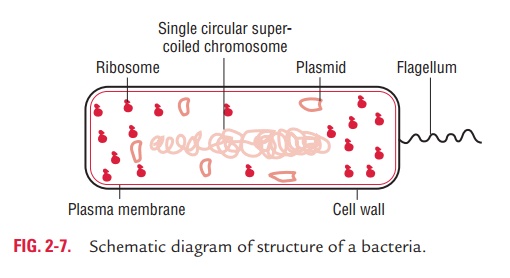Chapter: Microbiology and Immunology: Morphology and Physiology of Bacteria
Cytoplasm - Structure and Functions of Bacterial Cell Envelope
Structure and Functions of Bacterial Cell Envelope
The outer layer or cell envelope provides a structural and physi-ological barrier between the protoplasm (inside) of the cell and the external environment. The cell envelope protects bacteria against osmotic lysis and gives bacteria rigidity and shape. The cell envelope primarily consists of two components: a cell wall and cytoplasmic or plasma membrane. It encloses the proto-plasm, which consists of (i) cytoplasm, (ii) cytoplasmic inclu-sions (mesosomes, ribosomes, inclusion granules, vacuoles), and (iii) a single circular DNA (Fig. 2-7).

Cytoplasm
Bacterial cytoplasm is a colloidal suspension of a variety of
organic and inorganic solutes in a viscous watery solution. The matrix is
largely formed by nearly 70% water. Cytoplasm contains all the biosynthetic
components required by a bacterium for growth and cell division, together with
genetic material. Prokaryotic cytoplasm, unlike that of eukaryotes, lacks
endoplasmic reticulum and mitochon-dria. It also does not show any protoplasmic
streaming. Bacteria lack a true cytoskeleton. The cytoplasm consists of
ribosomes, mesosomes, and intracytoplasmic inclusions bodies.
Ribosomes: The cytoplasmic matrix often
is packed with ribo-somes. Ribosomes look like small, featureless particles at
low magnification in electron micrographs. They are smaller than their
eukaryotic counterpart with sedimentation of 70S, com-pared with 80S in
eukaryotes. They consist of two subunits of 30S and 50S, giving a net 70S.
Ribosomes are important because:
·
They serve as the sites of protein synthesis; matrix ribo-somes
synthesize proteins destined to remain within the cell, whereas plasma membrane
ribosomes make proteins for transport to the outside.
·
They are also the sites of actions of several antibiotics, such as
amino glycosides, macrolides, and tetracyclines.
Mesosomes: These are vesicular
convoluted or multilaminatedstructures formed as invagination of the plasma
membrane into the cytoplasm. Mesosomes are of two types—septal and lateral. The
septalmesosome attached to the bacterial DNA is believed to coordinate nuclear
and cytoplasmic divisionsdur-ing binary fission. The function of lateral
mesosomes still remains to be known. Mesosomes are analogous to the
mito-chondria of eukaryotes and are the principal sites of respiratory enzymes
in bacteria.
Intracytoplasmic inclusion
bodies: Intracytoplasmicinclu-sion bodies are present in the protoplasm of
bacteria. Their main function is believed to be of storage. This occurs when
their main constituent element is present in excess in the cul-ture medium.
Since inclusion bodies are used for storage, their quantity can vary depending
on the nutritional status of the cell. They are the sources of carbon,
inorganic substances, and energy. Some inclusion bodies also function to reduce
osmotic pressure.
They may be of two types:
(i) organic inclusion bodies, which
usually contain either glycogen or polyhydroxybutyrate, and (ii) inorganic inclusion bodies, which
may be of polyphosphate granules or sulfur granules. Examples of
intracytoplasmic inclusion bodies include metachromatic granules or volutin
granules, starch inclusions, and lipid inclusions. Volutin granules, typically
present in C. diphtheriae, can be
demonstrated by Albert’s stain. Similarly, starch granules present in the
bacteria can be demonstrated on staining with iodine. Lipid inclusion found in
Mycobacteria is demonstrated by Sudan black dye.
Related Topics